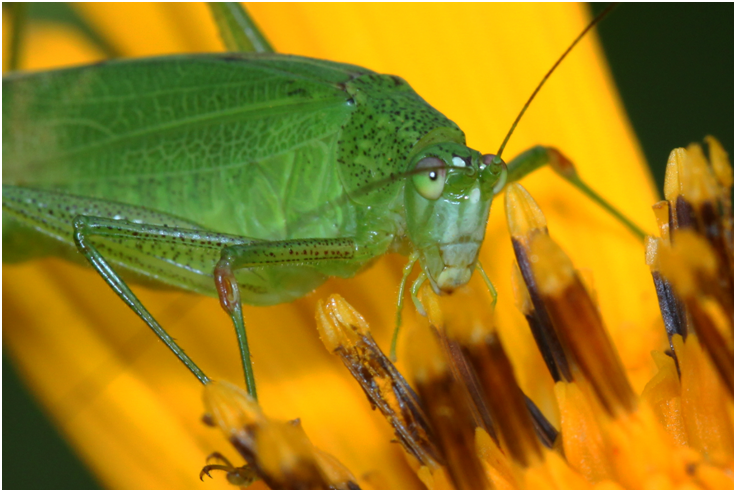- A new paper describes 41 species of orthopterans — grasshoppers, crickets and katydids — visiting flowers, making them potential pollinators.
- More research is needed to understand what role these insects, often viewed as crop destroyers, play in pollination.
- Insects worldwide are in crisis due to pesticide use, loss of habitat and climate change.
Attitudes toward grasshoppers and other leggy insects were immortalized in popular culture with Disney Pixar’s 1998 animated hit “A Bug’s Life.” “They come, they eat, they leave,” a main character chants breathily, a mantra likely shared by farmers the world over as they wait for the villainous grasshoppers to take their cut of the harvest and depart. But while some orthopterans, the order of insects that includes grasshoppers, crickets and katydids, can and do cause serious damage to crops, most don’t live up to their reputation for voraciousness. In fact, some species may actually provide a vital ecological service as pollinators, according to a recent study in the Journal of Orthoptera.
Scientists have documented orthopteran pollinators before, but these records, often sporadic, are mostly confined to South America. Now, new research led by doctoral student Tan Ming Kai with the National University of Singapore has documented 41 different species of orthopterans visiting flowers, dwarfing estimates from previous studies.
Tan and his team traveled to four different countries in Southeast Asia to complete the most comprehensive survey of flower-visiting orthopterans anywhere in the tropics.
Tan, who has been interested in orthopterans since keeping them as pets when he was young, says that finding some of them acting as pollinators is unsurprising, given the vast diversity in the order.
Watch the video of a katydid eating pollen: https://esajournals.onlinelibrary.wiley.com/action/downloadSupplement?doi=10.1002%2Fecy.2369&file=ecy2369-sup-0002-VideoS1.mp4

“I was more surprised with the great number of species visiting flowers … as well as with the lack of study on their pollination services,” he said.
Researchers estimate that more than a third of crop pollination carried out by insects is done by groups other than bees, like flies, beetles and butterflies. Grasshoppers and crickets are rarely counted among that number.
“My hope is that [people] can have a different perception of orthopterans, that not all species are pests and that some species can be potentially beneficial,” Tan said.
Orthopterans are also essential to ecosystems as prey for other animals, like birds and bats.
Tan and his group observed insects in several different ecosystems, including gardens, scrublands and various types of tropical forest. While in the field, they watched flowers for orthopterans eating petals or for individuals carrying pollen. Many orthopterans are nocturnal, so Tan’s team made lots of late-night observations.
This finding comes at a critical time for global insects. Recent research has shown that insects all over the world are experiencing dramatic population declines, prompting concern about the impacts on ecosystems and agriculture. This “insect apocalypse” has been widely reported, and so far fingers are pointing to a wide variety of factors, including climate change, habitat loss and pesticide use.

“I suspect that the orthopterans are probably affected just as much as other well-known insects [like honeybees and monarch butterflies] by pesticides and land use changes,” Tan said.
In the U.S. alone, insects are estimated to contribute as much as $29 billion per year to overall farm income through pollination — and orthopterans may well account for part of that number.
Tan said he believed his group’s findings might convince farmers to shift their pest control strategies away from insecticide use. Some orthopterans can be distracted by the presence of certain species of flowering plants, which could cause them to eat fewer commercially valuable crops, according to other research from Tan’s group.
“One can plant more flowering species so that attention can be shifted towards the flowers instead of the main crops,” he said.

Tan emphasized the importance of continuing to learn more about orthopterans.
“The lack of study and information might … hinder our understanding of these insects and the impact of excessive human activities,” he said.
In some areas of the world, it seems that humans are the ones who come, eat and leave; perhaps if we learn to better understand the animals whose world we share, we can make sure there is enough for everyone.
Citations
Lockwood, J. A. (1998). Management of orthopteran pests: a conservation perspective. Journal of Insect Conservation, 2(3-4), 253-261.
Rader, R., Bartomeus, I., Garibaldi, L. A., Garratt, M. P., Howlett, B. G., Winfree, R., … & Bommarco, R. (2016). Non-bee insects are important contributors to global crop pollination. Proceedings of the National Academy of Sciences, 113(1), 146-151.
Tan, M. K., Artchawakom, T., Wahab, R. B. H. A., Lee, C. Y., Belabut, D. M., & Tan, H. T. W. (2017). Overlooked flower-visiting Orthoptera in Southeast Asia. Journal of Orthoptera Research, 26 (2), 143-153.
Tan, M. K., Goh, F. N., & Tan, H. T. W. (2018). Consistent Between-Individual Differences in Foraging Performance in a Floriphilic Katydid in Response to Different Choices. Environmental Entomology, 47(4), 918-926.
Tan, M. K., & Tan, H. T. (2018). A gentle floriphilic katydid Phaneroptera brevis can help with the pollination of Bidens pilosa. Ecology, 99 (9), 2125- 2127.
